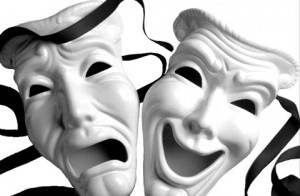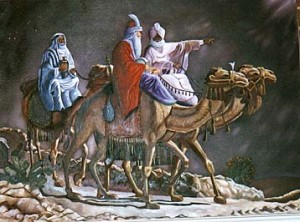A few years ago (2003) somebody asked me to address the Dutch IT Architecture Congress. The subject was the Human Measure. To understand the Human Measure you have understand the relationship between the Human Being and The Human Measure System, The Emotions.
At that time I was already highly influenced by Will McWhinney so I used his model of the Four Worldviews to describe the Human. Later I discovered a Fifth Worldview (Consciousness) that was hidden in his teachings.
The consciousness is the monitor of the Whole of the Human Being. It reflects about the behavior of the parts and takes action when the Whole is not in Balance (Stressed).
According to Will McWhinney the Human can be described by The Emotions (Values), The Imagination (Ideas), The Senses (Desire, Facts) and the Expectation (Control, Rules).
The Four parts can be combined in six (or twelve = 4x3x2) Games. A Game is a strategy to solve the Conflict between the Four Independent Parts.
To me it is very clear that IT is focused on the combination Expectation/Senses. This combination is called the Analytical Game. It solves the Conflict between Facts and Rules. Will showed that this game was the dominating game in Western Culture.
In the Analytical Game the Emotions, the Consciousness and the Imagination are not important. In the Analytical Game you want to find the Absolute Truth, The Rules of the Game, by Analyzing the Facts sensed by the Eyes.
When you want to understand the Emotions you have to look at “emotional” Psychology. When you start to study “emotional” psychology the “box of Pandora” of Psychology opens up. Psychology is not a science like Mathematics or Physics. Everybody has his own theory about Emotions and everybody is defending his own “territory”. Psychology is simply a scientific mess.
One of the most helpful scientists (a friend of Will) was Rodney Cotterill. Cotteril analyzed the evolution of the Sensory-Motor System of every Organism on Earth. The Sensory-Motor System is an Interaction between the Emotions, the Motor, and the Senses.
The bacteria is drifting around, explores an inhomogeneous environment that contains all kinds of chemical structures. Some of these structures are destructive, some of them are neutral and some of them are attractive (food). When the bacteria finds (senses) food his rotator (the flagellum) moves the bacteria in a circular motion. The circular motion of the bacteria is preserved for a short time and this preservation could be called memory
The emotions are aimed at the survival of the human being. They Explore environments to find something that helps them to survive and Avoid destructive environments. When Humans have found an Attractive environment they Stay there and Store the data about the environment in their Memory. Humans are Moving Memories (E-motion means movement!).
According to Rodney Cotterill the Emotions are the basic structure, the infrastructure, of an organism. All the other structures are specializations of one of the parts (the Sensors, the Calculator (Imagination, Expectation)) of the Emotional Infrastructure.
IT is highly focused on Sensors and Calculators (the Senses and the Expectation). IT has no idea what to do with the Emotions, the E-Value-ator, the basic Measurement System of the Human Being. The main objective of the Evaluator is to find Food and to stay Alive.
The Human Imagination has created many “abstractions” of Food and Secure Environments. They are all stored in the Memory as Symbols and Metaphors but it is not difficult to define what Humans don’t like. They don’t like the same thing IT-experts don’t like. IT-experts want to be Valued. They don’t want to be Dominated. They demand the freedom to Express their Creativity. They don’t want to play a role in a Play that was Designed by somebody else.
IT-experts love to play the Analytical Game. In this Game the Humans, called the Users play the role of the Object, the reusable Module, that has to do its Job. In the Analytic Game Users don’t have Emotions and Imagination. They have to Eat the Food that grew out of The Seeds of the Imagination of the Architect.
What is the Human Measure?
The basic measure of the Human Being is related to everything that gives him or her a feeling, an Emotion, of Security. The Human Value-System, the Emotions, is always looking for Shelter, Protection and Love. Humans Beings need other Human Beings to tell and show them that they are Value-able.
If the Human Being has an Expectation this Expectation has to be realized in the near Future.
When the Emotions of the Human Being are Dominated it wants to move away from his environment because a dominating environment could be Destructive. When something or somebody is Dominating a Human Being he/she feels worthless.
If the Imagination of the Human Being experiences No Change, (Highly Repeating Actions) it wants to Explore a new Environment.
If the Senses experience Too Much Change the Human Being becomes Confused. When you are Confused your Expectation fails and the Human starts to drift around just like the bacteria.
If the Human Being is not Conscious (Aware, Focused) it is unable to Reflect. If the Human Being is not Aware he is unable to Balance the Emotions, the Imagination, The Expectation and the Senses. If there is no balance the Body becomes Stressed. A Stressed Body slowly kills the Immune System. An Unbalanced Immune System is the Cause of many Diseases.
What is IT Doing?
IT is still creating Dominating, Always Changing, Insecure and Confusing Software.
IT is not automating the repeating activities Humans don’t like. IT is producing highly disconnected software-systems.
IT is not helping the Humans to makes senses of the complexity of the Outside World. IT is increasing the Complexity of the Environment.
IT is not supporting the Human to explore its environment. IT is shielding the outside environment and is creating an artificial outside environment. Many people believe the Imaginary World is the Real World. The most destructive artificial worlds are the Destructive Computer Games. They give the Player the Believe that Killing People is no problem at all. The destructive Games are the Games of the Military. They kill people by looking at simulators and pushing buttons.
IT is Playing the Same Game using Different Terminology all the time. If you understand the transformation of the terminology the Game is Boring. If you don’t understand the terminology the Game is Confusing. If you Mix the Terminology the Game is too Complex to Play. Almost nobody knows the Rules so many People make mistakes, believe they win the Game but in reality lose the Game.
What to do?
Perhaps somebody is able to Invent a New Game.
I have an Idea.
Why don’t we create a Game that Creates Games? According to the Theory of Will this Game is called the Game of Culture. It solves the conflict between The Imagination (The Creator) and the Emotions (The Mover). When the Mover is Inspired by the Creator the Sensory/Motor-System starts to Act with Spirit (Imagination) and Soul (Emotions). In terms of Emotional Psychology: The Human becomes Highly Moti-vated!
If we look at the theory of Will we now can see that the Analytical Game is the Complement of the Game of Culture.
If we Unite the two Games, the Games of the West and the Games of the East, we are able to connect all the parts of the Human Being in a Cycle, the Cycle of Human Innovation.
LINKS
About the Human Measure
 Erving Goffman
Erving Goffman  I want to tell you something about Games. What I want to show is that behind many Games there is a simple structure.
I want to tell you something about Games. What I want to show is that behind many Games there is a simple structure. It does not want his Expectations of the Future to Fail. The Fear to Lose Control changed the many Games Levels into one level of Play.
It does not want his Expectations of the Future to Fail. The Fear to Lose Control changed the many Games Levels into one level of Play. A part of the History of Christianity can be traced back to the
A part of the History of Christianity can be traced back to the 